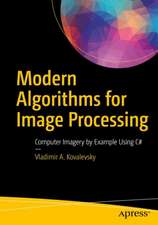Design Patterns in C#: A Hands-on Guide with Real-world Examples
Autor Vaskaran Sarcaren Limba Engleză Paperback – 25 sep 2020
Get hands-on experience with each Gang of Four (GoF) design pattern using C#. For each of the patterns, you will see at least one real-world scenario, a coding example, and a complete implementation including output. In addition to GoF patterns, you will learn additional design patterns which are common and equally important.
In this second edition, you will go through the design patterns and their implementation in Visual Studio 2019 and C# 8. Common patterns in asynchronous programming are covered, including the TAP pattern and APM pattern. You will learn via easy-to-follow examples and understand the concepts in depth. With these updated patterns, you will have a collection of programs to port over to your own projects.
The book begins with the 23 GoF design patterns, and then moves onto alternative design patterns, including the Simple Factory, Null Object, and MVC patterns plus various patterns in asynchronous programming. Thebook concludes with a discussion of the criticisms of design patterns and chapters on anti-patterns.
Each chapter includes a Q&A session that clears up any doubts and covers the pros and cons of each pattern. FAQs will help you consolidate your knowledge.
What You Will Learn
- Work with each of the design patterns
- Implement the design patterns in real-world applications
- Select an alternative to these patterns by comparing their pros and cons
- Use Visual Studio Community Edition 2019 to write code and generate output
Who This Book Is For
Software developers, testers, and architects
Preț: 282.60 lei
Preț vechi: 353.25 lei
-20% Nou
Puncte Express: 424
Preț estimativ în valută:
54.09€ • 56.72$ • 44.69£
54.09€ • 56.72$ • 44.69£
Carte disponibilă
Livrare economică 09-23 ianuarie 25
Preluare comenzi: 021 569.72.76
Specificații
ISBN-13: 9781484260616
ISBN-10: 1484260619
Pagini: 640
Ilustrații: XXXV, 640 p. 130 illus.
Dimensiuni: 178 x 254 x 40 mm
Greutate: 1.16 kg
Ediția:2nd ed.
Editura: Apress
Colecția Apress
Locul publicării:Berkeley, CA, United States
ISBN-10: 1484260619
Pagini: 640
Ilustrații: XXXV, 640 p. 130 illus.
Dimensiuni: 178 x 254 x 40 mm
Greutate: 1.16 kg
Ediția:2nd ed.
Editura: Apress
Colecția Apress
Locul publicării:Berkeley, CA, United States
Cuprins
Part-I: Gang of Four Design Patterns.- Part I.A: Creational Patterns.- Chapter 1: Singleton Pattern.- Chapter 2: Prototype Pattern.- Chapter 3: Builder Pattern.- Chapter 4: Factory Method Pattern.- Chapter 5: Abstract Factory Pattern. - Part I.B: Structural Patterns.- Chapter 6: Proxy Pattern.- Chapter 7: Decorator Pattern.- Chapter 8: Adapter Pattern.- Chapter 9: Facade Pattern.- Chapter 10: Flyweight Pattern.- Chapter 11: Composite Pattern.- Chapter 12: Bridge Pattern.- Part I.C: Behavioral Patterns.- Chapter 13: Visitor Pattern.- Chapter 14: Observer Pattern.- Chapter 15: Strategy Pattern.- Chapter 16: Template Method Pattern.- Chapter 17: Command Pattern. - Chapter 18: Iterator Pattern.- Chapter 19: Memento Pattern.- Chapter 20: State Pattern. - Chapter 21: Mediator Pattern.- Chapter 22: Chain of Responsibility Pattern.- Chapter 23: Interpreter Pattern.- Part-II: Additional Design Patterns.- Chapter 24: Simple Factory Pattern.- Chapter 25: Null Object Pattern.- Chapter 26: MVC Pattern.- Chapter 27: Patterns in Asynchronous Programming.- Part-III: Final Thoughts on Design Patterns.- Chapter 28: Criticism of Design Patterns.- Chapter 29: Anti-patterns.- Chapter 30: FAQs.- Appendix A: A Brief Overview of GoF Design Patterns.- Appendix B: Useful Resources.- Appendix C: The Road Ahead.- Appendix D: Important Updates in the Second Edition.-
Notă biografică
Vaskaran Sarcar obtained his Master of Engineering in software engineering from Jadavpur University, Kolkata (India) and an MCA from Vidyasagar University, Midnapore (India). He was a National Gate Scholar (2007-2009) and has more than 12 years of experience in Education and the IT industry. Vaskaran devoted his early years (2005-2007) in teaching at various engineering colleges, and later he joined HP India PPS R&D Hub Bangalore .He worked there until August, 2019. At the time of his retirement from the IT industry, he was a Senior Software Engineer and Team Lead at HP. To follow his dream and passion, Vaskaran is now an independent full-time author. Other books by him include: •Getting Started with Advanced C# (Apress,2020) •Interactive Object-Oriented Programming in Java Second Edition (Apress,2019) •Java Design Patterns Second Edition (Apress,2019) • Design Patterns in C# (Apress,2018) •Interactive C# (Apress,2017) •Interactive Object-Oriented Programming in Java(Apress,2016) •Java Design Patterns(Apress,2016) •C# Basics: Test Your Skills(Createspace,2015) •Operating System: Computer Science Interview Series(Createspace,2014)
Textul de pe ultima copertă
Get hands-on experience with each Gang of Four (GoF) design pattern using C#. For each of the patterns, you will see at least one real-world scenario, a coding example, and a complete implementation including output. In addition to GoF patterns, you will learn additional design patterns which are common and equally important.
In this second edition, you will go through the design patterns and their implementation in Visual Studio 2019 and C# 8. Common patterns in asynchronous programming are covered, including the TAP pattern and APM pattern. You will learn via easy-to-follow examples and understand the concepts in depth. With these updated patterns, you will have a collection of programs to port over to your own projects.
The book begins with the 23 GoF design patterns, and then moves onto alternative design patterns, including the Simple Factory, Null Object, and MVC patterns plus various patterns in asynchronous programming. The book concludes with a discussion of the criticisms of design patterns and chapters on anti-patterns.
Each chapter includes a Q&A session that clears up any doubts and covers the pros and cons of each pattern. FAQs will help you consolidate your knowledge.
You will:
- Work with each of the design patterns
- Implement the design patterns in real-world applications
- Select an alternative to these patterns by comparing their pros and cons
- Use Visual Studio Community Edition 2019 to write code and generate output
Caracteristici
Includes full implementations of each pattern, along with snapshots of the Solution Explorer views and output Presents real-world examples for each pattern Uses simple and effective language to convey complex information























